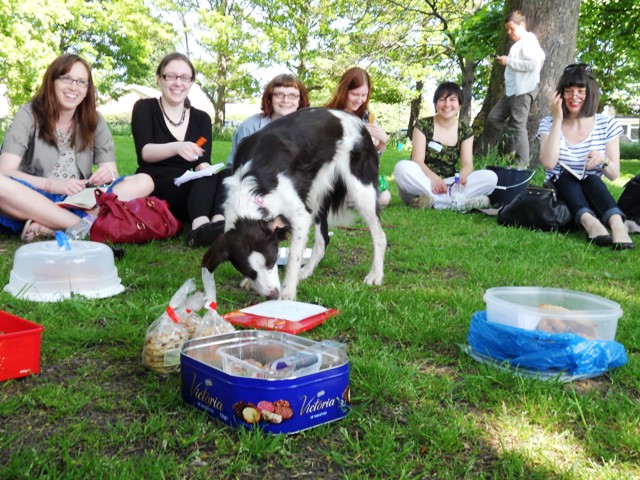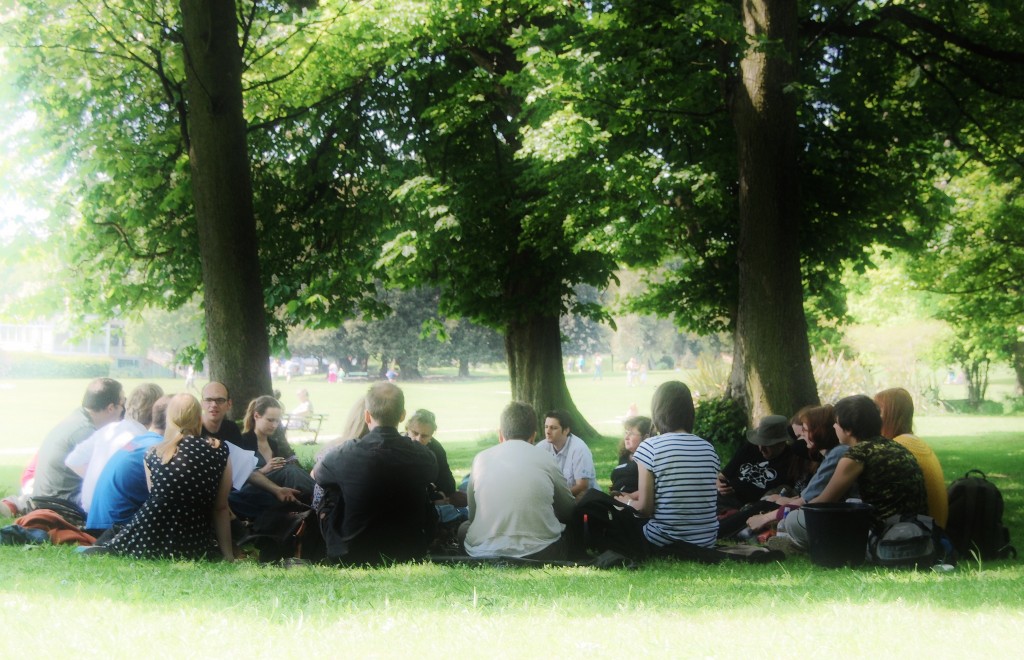On Saturday 26th May I attended Library Camp Leeds (libcampLS), a regional library unconference hosted by Leeds City Libraries. The conference took place on a beautiful sunny day at Horsforth library.
In a masterful move by the organizers we decamped to nearby Hall Park for the afternoon sessions which meant the session I had pitched on library catalogues took place ‘en plein air’. The unconference style made this easy to accomodate though there were some downsides, notably a dog that turned up and dug into Dace‘s salty cheese sticks just as the session was getting started…

The anti-social catalogue

What is the next-gen library catalogue?
I opened by outlining what we mean by a “discovery interface” or “next-generation library catalogue” to give us some grounding. Then I gave a quick outline of the failure of current library systems to be “social”, that is, how they don’t facilitate social interactions.
I paraphrased from Sharon Yang and Melissa Hoffman’s article (2011) surveying library catalogues. I’ll repeat this below as I know it’ll come in handy in future. What makes something a next-generation catalogue isn’t very well-defined but we can say such a system will have many of these features, whereas traditional catalogues have few:
- They provide a single point of searching across multiple library resources including the local bibliographic database, journal articles, and other materials.
- The Web interface is modern and its design reflects that that found in Web search and ecommerce sites rather than traditional bibliographic retrieval systems.
- They favour keyword searching via a single search box.
- They feature faceted navigation to rework or limit search results.
- They are tolerant of user error and provide “Did you mean…?” suggestions.
- They feature enriched content drawn from sources outside the library such as book jackets, reviews, and summaries.
- They feature user-generated content such as reviews and tagging.
- They feature recommendations or suggestions for related material, which may be based on information held in the library system (e.g. circulation data) or elsewhere.
- They feature some kind of social networking integration to allow for easier sharing and reuse of library records and data on these Web sites.
- To facilitate this sharing, records have stable persistent links or permalinks.
What are the problems?
Some of the features mentioned above are social in nature, including user-generated content such as tagging and reviews, recommenders built from using circulation data, and integration of social networking sites. So “next-generation” implies a suite of features that include some social features, but not everything next-generation is such a social feature. Furthermore the underlying library management system and metadata are not likely to be too supportive of these features.
In practise social features like tagging and reviews haven’t really taken off in libraries and those of us using these tend to find low use among our customers. This is certainly my experience with tagging, enabled on our Encore catalogue at Senate House Libraries. It is not enough to have a reasonably large bibliographic database and a reasonably large membership then turn on tagging and expect something – the magic – to happen.
I do not think library catalogues are perceived as a social destination by our readers. However I think what prevents this is not that there is no wish by readers to interact in this way using our systems, but that we’re only just starting to make a serious effort to build features that encourage genuine social interaction.
This is what I mean by current catalogues being anti-social. However, I did like this alternative definition from Gaz:
Technically I’m in a group about anti-social catalogues. That come around your library and burn all your books! #libcampls
— Llordllama (@llordllama) May 26, 2012
Discussion
Note: attributions below are based on my notes from the day. If I’ve made a mistake please let me know.
The conversation was lively and varied and I was really pleased to facilitate a session where so many present wanted to contribute.
There was a general feeling the current technology isn’t there yet and implementation of social features on our catalogues do not encourage social interaction.
Luke explained catalogues built by vendors reflect the small marketplace offered by libraries and that technology in libraries tends to be quite far behind leading edge. He described the development of VuFind for discovery based on frustration with software supplier offerings – but one that required a willingness to invest in staff resource to develop and implement VuFind. This was done at Swansea University, Swansea Metropolitan University, and Trinity Saint David as a project – SWWHEP.
Luke mentioned something I have heard as a common objection to user-generated content in catalogues, the fear that students will abuse it and tag books with swearwords and so on. There was a similar concern raised that books written by academic staff might be rated down by students (with a cheeky suggestion added – “They should write better books”). Luke pointed out this has not proved a problem on the Swansea iFind implementation of VuFind (as it hasn’t at Senate House Libraries) because the feature is simply not being used. I thought that in some ways the feature being ignored is worse than readers actively disliking it…
Sarah gave an example of a ‘paper-based Web 2.0’ (my term) implementation where library members were given a paper slip to rate or review an item – which would then be keyed into the catalogue by staff!
Several campers made the point bringing in user-generated content from outside – such as Librarything for Libraries – could make a big difference as then there’s clearly something there to start with.
It was generally agreed building features that create good social interaction requires effort, it’s not something we can easily bolt on to existing systems that aren’t designed for this from the ground up.
There was agreement with Iman‘s point that for social features to become popular there should be an incentive for the customer. The customer should get value from the interaction, or what’s the point of doing it? Alongside this it shouldn’t take huge effort or require a great deal of work to be social. The concept of gamification as a way of providing that incentive was raised here.
Several campers gave example of where libraries know great a deal of information about our readers habits and actions, and could re-use this to enhance their experience of the physical or online library. The approach to social features on the catalogue that requires least effort are those interactions that happen by you doing what you would normally do anyway. For example borrowing and returning books to generate recommendations based on circulation information.
One problem was raised about emphasising top loaning items from the collection in that this could become self-sustaining: an item remaining popular because it is on that list. (At this point I wondered that I probably couldn’t make our top-loaning author Michel Foucault any more popular if I tried…)
Liz made a thoughtful point that the use of technology is important, that is how it enables us to fulfil the mission of the organization (the library, the university). We should concentrate on what’s relevant for our organizations. So: we need to be clear what we’re trying to achieve with these features and what the point of it all is. Technology used poorly for its own sake had already been raised, an example given being linking to an ebook record from the catalogue using a QR code: if you’re already online looking at the catalogue, why not just a normal hyperlink?
Rather than limiting ourselves to what other libraries are doing we should be thinking along the lines of features employed in ecommerce systems. Spencer made the interesting point that ecommerce systems he has worked with can build a much more complete picture of user needs and wishes with a view to offering them a tailored online experience. This is years ahead of anything libraries currently do.
Some more fundamental problems were raised about technology and libraries.
Linsey raised the idea of ’embarrassing IT’, that is IT provision that’s so bad we as information professionals are ashamed to offer it. Alison said the technology needs to be there to support new catalogues, or our staff and customers simply can’t make the best use of them. An example given by the group was of an older catalogue remaining popular versus a next-generation system because it’s faster to use on outdated computers provided by the library.
These problems aren’t minor. Feedback from the group was that our Web presence and user experience of our Web sites really influences users’ perception of our organizations. There’s a real need for us to do this well, not half-heartedly.
Acknowledgment
My thanks to Natalie Pollecutt at the Wellcome Library for helpful discussion about the concept of the ‘social catalogue’ ahead of libcampLS.
References
Yang, S.Q. and Hofmann, M.A. (2011). ‘Next generation or current generation?: a study of the OPACs of 260 academic libraries in the USA and Canada’, Library Hi Tech, 29 (2), pp. 266-300. doi:10.1108/07378831111138170

